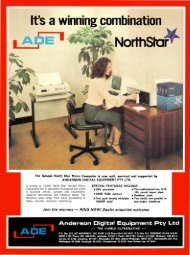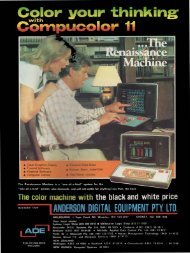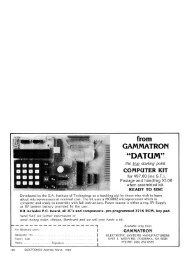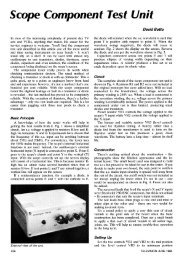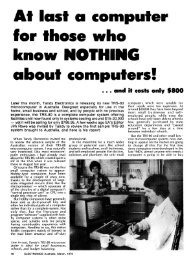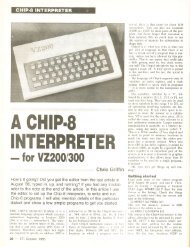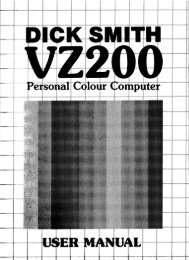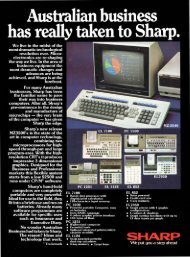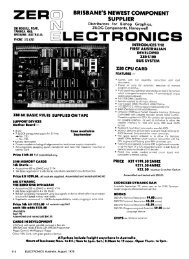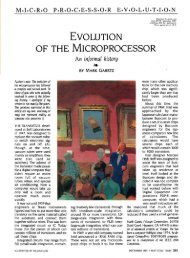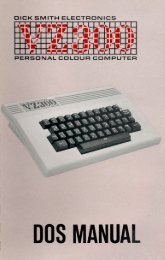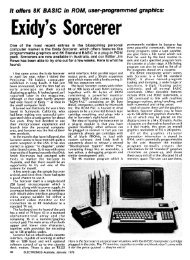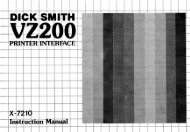Applied Technology and Microbee adverts. - The MESSUI Place
Applied Technology and Microbee adverts. - The MESSUI Place
Applied Technology and Microbee adverts. - The MESSUI Place
You also want an ePaper? Increase the reach of your titles
YUMPU automatically turns print PDFs into web optimized ePapers that Google loves.
A program incorporated in the Basic Interpreter<br />
determines which pixels of the<br />
character cell need to be illuminated <strong>and</strong><br />
where the character must be placed on<br />
the screen to create the display required.<br />
<strong>The</strong> same program keeps track of how<br />
many of the 128 programmable<br />
characters have been used <strong>and</strong> which of<br />
these can be over-written as more of the<br />
screen is filled.<br />
As long as displays are confined to vertical<br />
<strong>and</strong> horizontal lines this method<br />
works well. Diagonal lines exhaust<br />
memory space more quickly, <strong>and</strong> circular<br />
patterns or complex, full screen<br />
graphics are not possible.<br />
Internal details<br />
Opening up the MicroBee reveals two<br />
circuit boards, the upper containing a<br />
mixture of RAM <strong>and</strong> ROM <strong>and</strong> the lower<br />
carrying the Z80 microprocessor, video<br />
display circuitry, cassette interface, tone<br />
generator, keyboard <strong>and</strong> interface<br />
connectors.<br />
A st<strong>and</strong>ard <strong>Microbee</strong> has 16K of programmable<br />
memory, with room for onboard<br />
expansion to 32K. <strong>The</strong> other half<br />
of the memory board has space for up to<br />
28K of ROM. MicroWorld Basic occupies<br />
16K, with the remaining space available<br />
for utilities such as an editor/assembler,<br />
network communications program or a<br />
word processing package. Our review<br />
machine contained the word processor<br />
(of which more later).<br />
A feature of the <strong>Microbee</strong> is its use of<br />
CMOS memory which draws very little<br />
current. A 4.5V camera battery provides<br />
sufficient power to allow the memory to<br />
be maintained on st<strong>and</strong>by while the<br />
mains supply is off. <strong>The</strong> program in<br />
memory is retained, whether the user<br />
wants it or not.<br />
An RS-232C interface is provided for<br />
connection of a printer or other serial<br />
device. Two other openings at the rear<br />
of the case provide access to the circuit<br />
board, which is pre-drilled to allow addition<br />
of an expansion connector for the<br />
Z80 bus <strong>and</strong> parallel interface circuitry. A<br />
parallel port can be added by installing a<br />
25-pin D-type connector <strong>and</strong> a single integrated<br />
circuit.<br />
One of the reasons why the <strong>Microbee</strong><br />
is so compact is that it has an external<br />
power supply in the form of a 12VAC<br />
plugpack. This feeds rectifiers, filters <strong>and</strong><br />
three 5V regulators in the <strong>Microbee</strong>. As<br />
such, this arrangement could be improved<br />
upon. For a start, the plugpack<br />
voltage of 12VAC means that a relatively<br />
high DC voltage is fed to the regulators,<br />
lading to higher than necessary power<br />
dissipation in the case.<br />
High resolution (512 x 256) graphics displays can be over-printed with text as shown<br />
here. <strong>The</strong> incomplete design results when all programmable characters have been<br />
used.<br />
And it would seem that when the<br />
<strong>Microbee</strong> is fully optioned up, the power<br />
supply is not quite up to the task. While<br />
some owners have gone to the trouble<br />
of building a more rugged external supply<br />
it would seem that these problems<br />
could be overcome by providing a<br />
plugpack with a lower output voltage<br />
<strong>and</strong> a higher current rating, ie, with the<br />
same overall power rating.<br />
Power is supplied to the <strong>Microbee</strong><br />
from the 12VAC plugpack with a 5-pin<br />
DIN connector. <strong>The</strong> same connector is<br />
also used for the cassette interface connections<br />
<strong>and</strong> direct video output. <strong>The</strong>re<br />
is no RF modulator, so attempting to<br />
connect the computer to a st<strong>and</strong>ard<br />
television set is doomed to failure.<br />
<strong>The</strong> manual accompanying the<br />
machine makes no mention of the need<br />
MicroBee specifications<br />
for a direct entry video monitor. In the<br />
same fashion it is not until page 124 of<br />
the 144 page booklet that instructions<br />
are given for connecting a cassette<br />
recorder — <strong>and</strong> even then the manual<br />
refers to a red plug which is actually<br />
grey. Considering that a demonstration<br />
tape intended for classroom use was included<br />
. with the computer, this is a<br />
serious failing.<br />
All in all, the manuals supplied with the<br />
<strong>Microbee</strong> suffer from the common failing<br />
of those written by someone too<br />
close to the subject. Features not commonly<br />
used are treated in loving detail<br />
while vital information for the beginner<br />
is either glossed over or missing entirely.<br />
At the time of this review an extensive<br />
re-writing of the manuals was underway,<br />
so these comments may not be ap-<br />
Processor: Z80<br />
RAM: 16K, exp<strong>and</strong>able on-board to 32K, with battery back-up<br />
ROM: 16K, exp<strong>and</strong>able on-board to 28K<br />
Interfaces: RS232C serial port, optional parallel port <strong>and</strong> S-100 expansion.<br />
Keyboard: 60 keys including spacebar, typewriter style<br />
Display: 64 x 16 upper <strong>and</strong> lower case, underline <strong>and</strong> inverse video modes<br />
Graphics: High resolution, 512 x 256 using programmable characters Low<br />
resolution 128 x 48<br />
128 programmable characters, 8 x 16 pixel matrix<br />
Sound: 25 tones with duration in increments of 143 second.<br />
Expansion: 64K memory version, S-100 interface, disk drives<br />
Editor/Assembler, word processor <strong>and</strong> network communications software is<br />
available in ROM<br />
Documentation: Incomplete at time of writing.<br />
ELECTRONICS Australia, February, 1983 95



